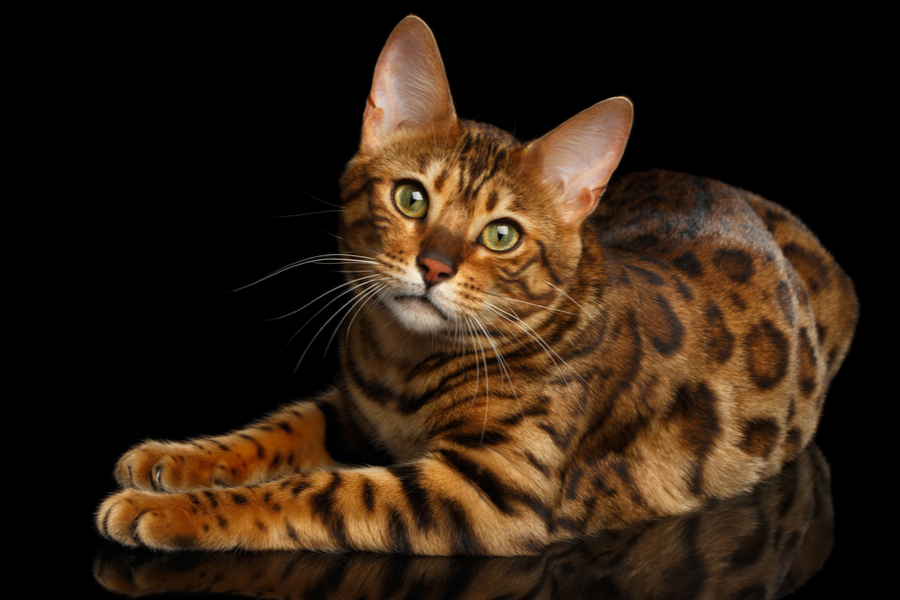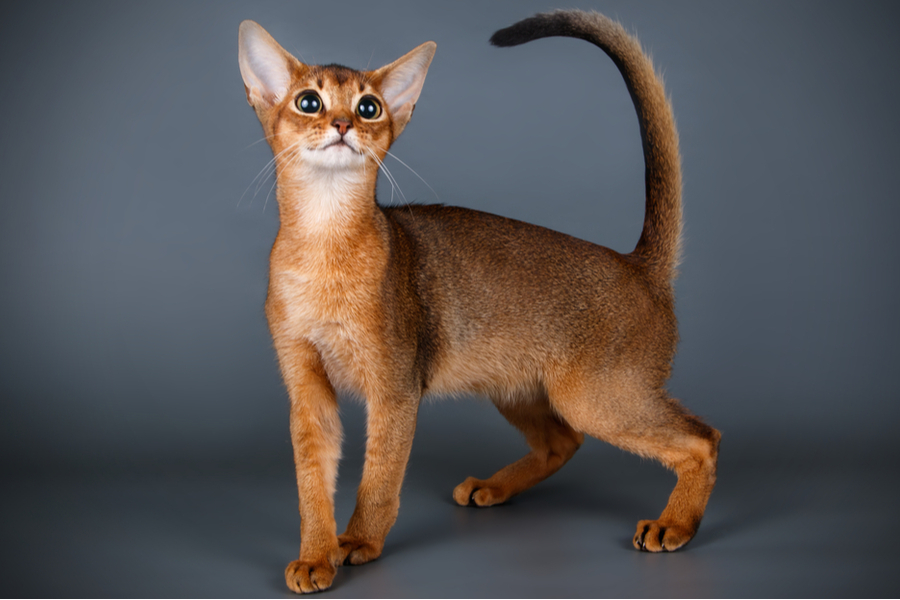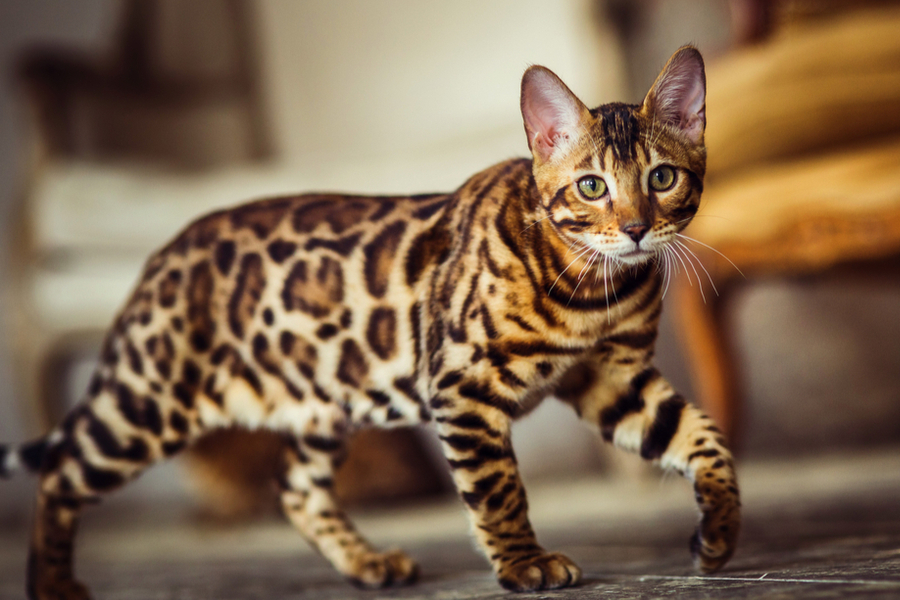Two of the most intelligent and playful cat breeds are the Abyssinian and the Bengal. In terms of their energy levels and intellect, these two desirable breeds are relatively similar. However, there are many key differences between them, both in their physical looks and personality traits.
So, if you’re torn between these two entertaining, easy-to-train cat breeds, check out our ultimate breed comparison. Then, armed with all the information you need, you can decide whether an Abyssinian or a Bengal is the best fit for you.
Abyssinians vs Bengals: Quick Comparison
| Abyssinian | Bengal | |
| Origin: | Ethiopia/ Asia | United States |
| Adult weight: | 4 – 5 kg (8 – 12 pounds) | 5 – 7 kg (11 – 16 pounds) |
| Life span: | 9 – 13 Years | 12 – 16 years |
| Coat: | Short | Short |
| Shredding: | Moderate | Moderate |
| Grooming needs: | Low | Moderate |
| Trainable: | Yes | Yes |
| Good with children: | Yes | Yes |
| Colour: | Ruddy (tawny/usual), cinnamon, blue, and fawn | Brown, Black, Grey, Spotted |
Physical appearance
The Abyssinian and Bengal cats have wild-looking appearances with long, lean bodies and an athletic build. They both have long legs (which make them excellent jumpers), but Bengals tend to grow larger and weigh more than Abyssinians.
They are both short-haired breeds, but they have very different coat patterns. Bengals have super soft fur, and sport spotted, marbled or rosette markings in various shades of brown or silver. This leopard print pattern reflecting their wild Asian leopard ancestry is the most distinctive trait that sets Bengals apart from all other cat breeds.
The Abyssinians coat is also unique, with complex ticking, a genetic variant of the tabby pattern. This means that each individual hair consists of multiple colours, which become more apparent under the light. Generally, the fur starts lighter in colour around their body, then alternates between bands of lighter and darker shades, moving out towards the tip of their tail.
Another distinctive feature of the Abyssinian is their ears. They are large in proportion to their head and slanted forwards, giving an always alert look. Bengals ears are more proportionate to the rest of their face.
Abyssinians can come in various colours. The most common is ruddy/ tawny, which has a reddish-brown base with black ticking. However, they can also be found in shades of blue, fawn, lilac, chocolate, and cinnamon. Bengal cat colours can vary too, although not as much as Abyssinians. Bengals will be a combination of shades of brown, black, red or grey.
Both breeds have gorgeous almond-shaped eyes. The most common eye colours for Bengals are brown, yellow, orange, and green. Abys usually have green or hazel coloured eyes, depending on their coat colour.
Personality and temperance
Bengals and Abyssinians are both highly active, playful, and curious cat breeds. However, neither are lapcats, and they spend their days playing, jumping, and hunting rather than lying around. They are both excellent climbers, too and will seek out high spots to perch on.
Bengals and Abyssinians require a lot of stimulation, but Bengals more so. Therefore, you will need to provide plenty of toys, cat trees and high platforms, especially if they do not have access to the outdoors.
They are also very confident, sociable, and friendly cats who love being around people of all ages. They seek attention from everyone and love interacting with their humans. They show their affection by following their owners around and by vocalising. However, Bengals are much louder than Abys and use louder and longer meows to get your attention. Abyssinians, on the other hand, use much softer chirps to speak to you.
While Abys also enjoy the company of other animals, Bengals are not so easygoing with other felines or canines. If introduced from an early age, Bengals will become friends with another pet. However, it may prove problematic if you try to bring a new animal into the home once the Bengal is older. Aby’s are much more likely to accept new animals in the home throughout their life. They are also much better at adapting to change in general, such as moving home.
One personality quirk of the Bengal is their love of water. You’ll notice a Bengal drinks more water than most other breeds, but they also love playing in the liquid too. Therefore, don’t be surprised if your Bengal follows you into the shower, dives under the kitchen tap, or even jumps in the bath with you!
Bengals have very wild instincts. So, if allowed outside, they will definitely bring you back many presents, such as mice, birds, and any other prey they can find.
Trainability
Both breeds are very smart and easy to train, especially if you start while they are young. They both also learn tricks and commands quickly and can be leash trained. However, because they are so intelligent, if you don’t take the time to teach them, they may start to train you and have you doing what they want, rather than the other way around!
Health and grooming
Bengals and Abyssinians are generally healthy breeds, but like all breeds, there are specific health conditions they may be prone to.
One concern for Bengals is Hypertrophic cardiomyopathy (HCM), a disease that affects the heart’s ability to pump blood. Abyssinians may develop gingivitis, which can lead to periodontal disease. However this can be easily prevented by regularly brushing your Aby’s teeth.
Progressive retinal atrophy is a degenerative eye disease that both breeds are prone to, which can lead to blindness if undetected and untreated.
Both Bengals and Abyssinians have low grooming needs and only require brushing once or twice a week to remove loose hair and dead skin cells, and keep their beautiful coat in top tip condition.
Final Thoughts
Both of these popular breeds display a dog-like loyalty and can develop strong bonds with their owners. However, neither likes to be left alone for too long. Therefore, whichever breed you choose, ensure you or another household member is regularly home to keep these furry felines happy and entertained.







